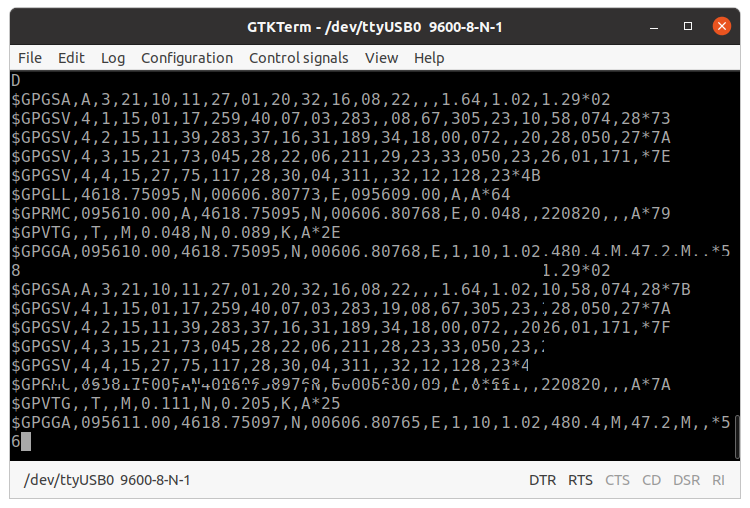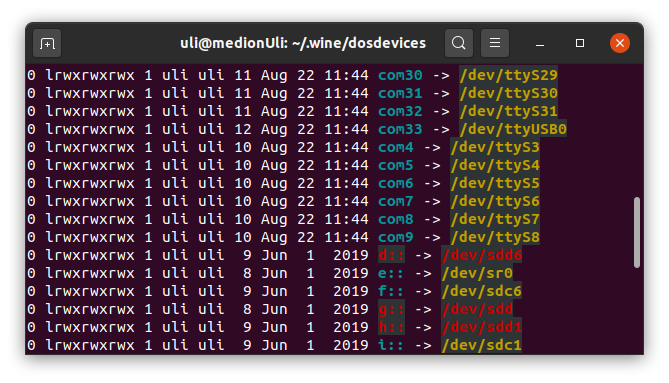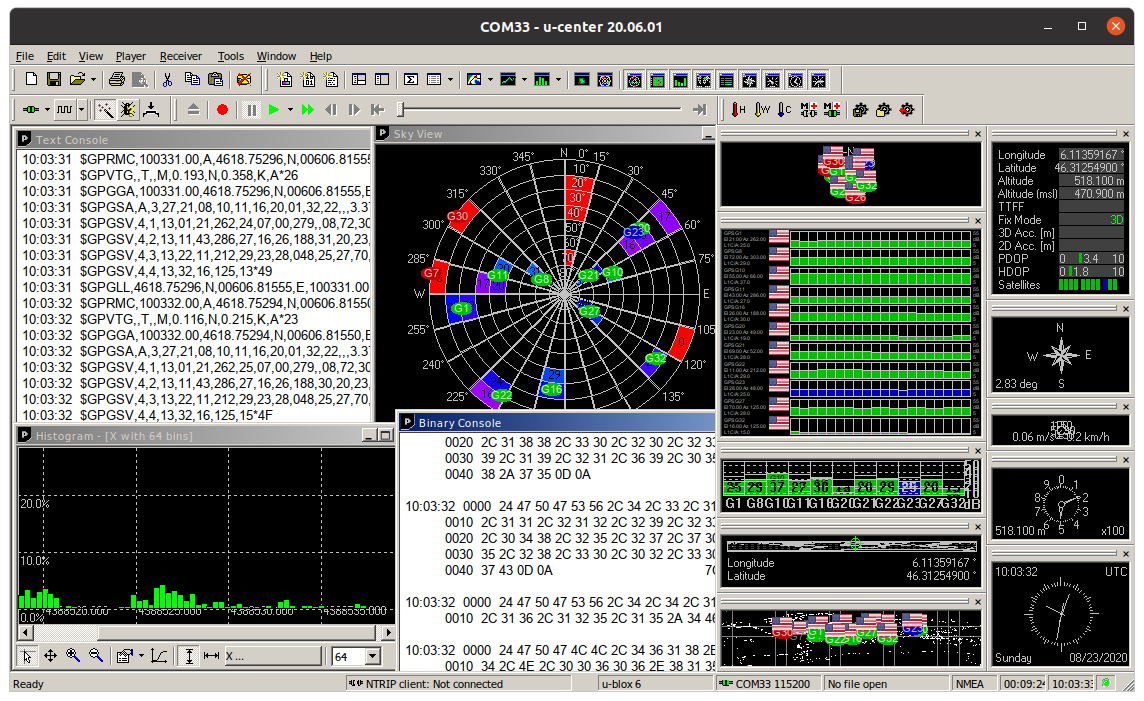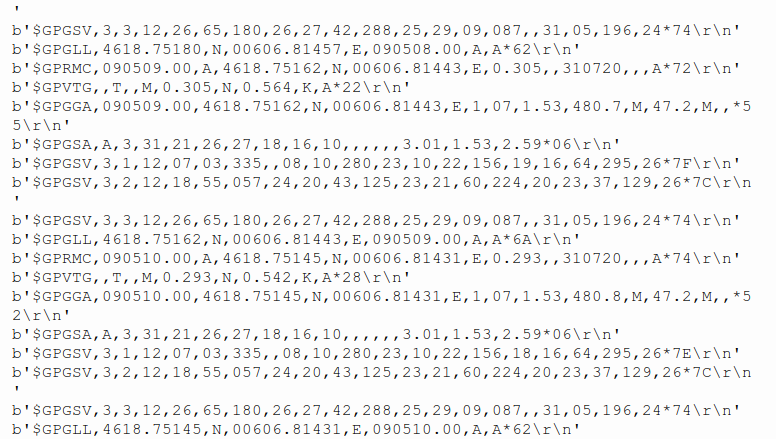The Neo 6M GPS receiver
Most GPS receivers use a UART to communicate with their hosts and the Neo 6M is no exception. The ESP32 has 3 hardware UARTs with the following default connections:
| UART number |
default Rx,Tx GPIO pins |
| 0 |
3,1 |
| 1 |
9,10 |
| 2 |
16,17 |
On our system UART 0 is reserved for REPL, GPIO 9 and 10 are not pulled out to the connector and GPIO 16,17 are used by PSRAM. Fortunately the ESP32 allows to re-map UARTs to just about any GPIO pin using the GPIO matrix and the MicroPython driver supports the re-mapping. We can define a UART as follows:
uart2=machine.UART(2, baudrate=9600, rx=21, tx=22, timeout=10000)
For more information about the ESP32 UART driver in MicroPython see
https://docs.micropython.org/en/latest/library/machine.UART.html#machine-uart
The card on which the Neo 6M GPS receiver is mounted has 4 connection pins (starting from the left):
| Pin on Neo 6M |
Pin on ESP32 bus |
| Vcc |
3.3V |
| Rx |
Rx: D1 = GPIO 22 |
| Tx |
Tx: D2 = GPIO 21, only needed if you want to modify parameters on the Neo 6M |
| Gnd |
Gnd |
Only Pin D2 or GPIO 21 is actually used and as you can tell from the instantiation of UART2 shown above the Neo 6M receiver communicates on 9600 baud.
Here is a photo of the device:

Connecting the GPS receiver to your PC
In order to read out the GPS receiver from the PC we need a USB to serial converter:

As can be seen on the photo the connections must be made as follows (pin 1 is the leftmost pin)
| Pin no on the USB to serial converter |
Label |
Connection on GPS receiver |
| 1 |
DTR |
nc |
| 2 |
RX |
Tx |
| 3 |
TX |
Rx |
| 4 |
VCC |
3.3V |
| 5 |
CTS |
nc |
| 6 |
GND |
GND |
If you now communicate with the USB to serial adapter on /dev/ttyUSB0 with a terminal emulator like minicom or gtkterm running on 9600 baud you should see NMEA messages sent be the GPS receiver.

ublox u-center
ublox provides a Windows application for its GPS receivers named u-center which you can download from
https://www.u-blox.com/en/product/u-center
. Its user guide can be found at
https://www.u-blox.com/sites/default/files/u-center_Userguide_%28UBX-13005250%29.pdf
. It is possible to run this application on Linux using the Windows emulator
wine. u-center allows you to connect to a Windows com port in order to communicate with the receiver. When running the u-center installation you will get the executable in
~/.wine/drive_c/Program Files (x86)/u-blox/u-center_v20.06.01
Finally we must figure out to which Windows com port our USB to serial adapter corresponds to. Looking at ~/.wine/dosdevices shows that /dev/ttyUSB0 is mapped to com33.

ublox GPS receivers use 2 different protocols
- the NMEA protocol
- a proprietary binary protocol, which not only transmits GPS data but also allows to configure the receiver
As mentioned above, the standard baud rate on the ublox neo 6M is 9600 baud, which is very slow. It takes ~ 600 ms to transmit the batch of NMEA sentences the receiver sends every second. When trying to parse the sentences as they come in real time I see many CRC errors, which may come from the fact that there is simply not enough time left for the data treatment before the next batch comes in.
u-center allows you to change the baud rate (I selected 115200 baud, which I also use to communicate with the ESP32) and to save this change in battery backed up RAM such that it can be recovered when the receiver is restarted after a power down.
Here is a screen dump of the running u-center application:

gpsd
The GPS daemon gpsd connects to a GPS receiver and provides its data to clients over a TCP connection.You can find it on
https://gpsd.gitlab.io/gpsd/index.html
Reading NMEA sentences with the ESP32
Once the connection is made and the UART instantiated all you need is an endless loop to read the UART line by line. This is what you will see if you print the result:

These are sentences of the
NMEA protocol. 
You will need a parser that extracts the relevant information from these messages. It is not too difficult to write such a parser yourself but why do you want to do it if the job has already be done for you? In fact Peter Hinch has a github repository with gps drivers containing all you need:
https://github.com/peterhinch/micropython-async/tree/master/gps
He uses the NMEA parser from
https://github.com/inmcm/micropyGPS
but adapted it to his asynchronous driver.
--
 Uli Raich - 2020-07-01
Uli Raich - 2020-07-01
Comments

 As can be seen on the photo the connections must be made as follows (pin 1 is the leftmost pin)
As can be seen on the photo the connections must be made as follows (pin 1 is the leftmost pin)

 ublox GPS receivers use 2 different protocols
ublox GPS receivers use 2 different protocols 
 These are sentences of the NMEA protocol.
These are sentences of the NMEA protocol. 


